Abstract
Photovoltaic Agriculture (PA) is a new management system combining industry with modern agriculture that can effectively reduce the competition for limited land resource usage between electric power production and agricultural production. However, PA has been facing the challenge of managing plant protection measures because it is difficult to monitor plants grown under the photovoltaic panels by remote sensing satellites and pesticide applications using drones. To overcome this challenge, Solar Insecticidal Lamps (SILs) can be used for phytoprotection in PA. However, to effectively use SILs in PA, it is important to identify a suitable field location to maintain strong wireless communication signals. In this paper, two testbeds were designed and a series of experiments in PA was performed. The results indicate that there is considerable interference exists around the confluence box. A higher interference seriously reduces the Packet Reception Rate (PRR) of the nearby node, which is an important constraint for deploying wireless sensors in PA. Finally, new challenges and future research opportunities are proposed.
1. Introduction
In recent years, the world’s economic and trade pattern has been continuously changing, while the Russia–Ukraine conflict has brought a more enormous and sustained impact on this pattern [1]. The international oil and gas prices have been continuously rising, leading to a big increase in the production and living costs for the countries importing both oil and gas, further aggravating the inflation crisis. At the same time, the Russia–Ukraine conflict stimulates all countries to strengthen their awareness of energy security and accelerate the progress of both new energy technologies and large-scale commercial utilization. Stimulated by the above-mentioned crisis, new energy technologies have been further developed, which can effectively alleviate the adverse effects of high energy prices and food security threats. Photovoltaic Agriculture (PA) is a new management system combining industry with modern agriculture and the distributed photovoltaic modules are built on specific spaces such as farmlands, pastures and waters. It allows crop cultivation under these modules, and power generation on the modules, resulting in cost sharing and complete integration between photovoltaic power and agricultural facility [2].
With the advantages of both low-cost and large-scale innovation, China occupies an absolute leading position in the global photovoltaic industry, while PA has also been continuously developed in China. The main modes of PA include photovoltaic agricultural greenhouses, agro-photovoltaic complementarity, forestry-photovoltaic complementarity, husbandry-photovoltaic complementarity, fishery-optical complementarity, and photovoltaic sand control.
- (1)
- Photovoltaic agricultural greenhouse: These greenhouses are built under photovoltaic panels, in which crop production is carried out. These are generally named photovoltaic greenhouses (Figure 1a [3]).
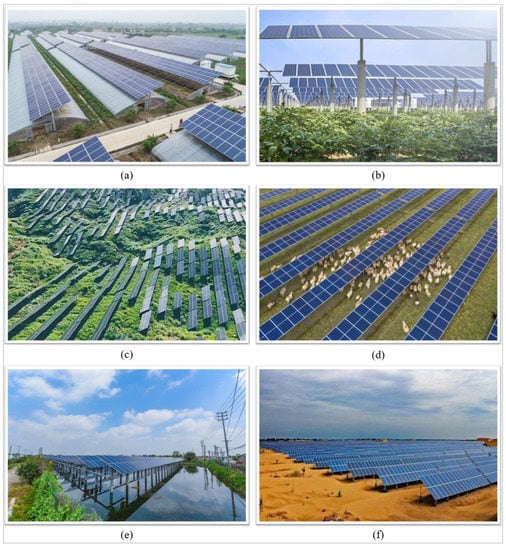 Figure 1. Six different modes of PA: (a) Photovoltaic agricultural greenhouse (Hongxingqiao Town, Changxing County, Zhejiang, China); (b) Agro-photovoltaic complementarity (Munson Hall Amherst, MA, USA); (c) Forestry-photovoltaic complementarity (Houping Village, Longgui Town, Shaoguan, Guangzhou, China); (d) Husbandry-photovoltaic complementarity (Qitai Village, Gonghe County, Qinghai, China); (e) Fishery-optical complementarity (Hefu Town, Zhejiang, China); (f) Photovoltaic sand control (Dunhuang City, Gansu, China).
Figure 1. Six different modes of PA: (a) Photovoltaic agricultural greenhouse (Hongxingqiao Town, Changxing County, Zhejiang, China); (b) Agro-photovoltaic complementarity (Munson Hall Amherst, MA, USA); (c) Forestry-photovoltaic complementarity (Houping Village, Longgui Town, Shaoguan, Guangzhou, China); (d) Husbandry-photovoltaic complementarity (Qitai Village, Gonghe County, Qinghai, China); (e) Fishery-optical complementarity (Hefu Town, Zhejiang, China); (f) Photovoltaic sand control (Dunhuang City, Gansu, China). - (2)
- Agro-photovoltaic complementarity: Crop production is performed under photovoltaic panels. These are generally called as photovoltaic farms (Figure 1b [4]).
- (3)
- Forestry-photovoltaic complementarity: Economically valued trees are grown under photovoltaic panels. These are generally called photovoltaic forestry (Figure 1c [5]).
- (4)
- Husbandry-photovoltaic complementarity: Animal husbandry is carried out under photovoltaic panels. These panels can also provide forage for the animals. These are generally called as photovoltaic pastures (Figure 1d [6]).
- (5)
- Fishery-optical complementarity: Aquaculture is practiced under photovoltaic panels. In these systems, intense light is prevented from directly hitting the water body and reducing the water temperature, which benefits some aquacultures. These are generally known as photovoltaic fishery (Figure 1e [7]).
- (6)
- Photovoltaic sand control: Soil management that contains more sandy proportions is practiced under photovoltaic panels. The shielding of panels can increase the water content in the sand and improve the survival probability of plants (Figure 1f [8]).
The initial cost of establishing a photovoltaic system for agricultural crop production systems is costlier than the photovoltaic system for fisheries. As shown in Figure 2, the number of new agriculture-related photovoltaic systems in China has surpassed that of fishery-optical complementarity systems from 2018 to 2019, with a tendency to continue in the future [9]. The smooth development of agro-photovoltaic complementarity projects needs to ensure a certain amount of power generation income, a certain amount of land for the PA system, and related agricultural production facilities, indicating that the three factors, including the coverage rate of photovoltaic panels, the policy of photovoltaic land utilization, and the agricultural equipment, should be considered in PA. The coverage rate of photovoltaic panels is closely related to the geographical environment. The policy of photovoltaic land utilization is also being gradually adjusted to adapt to the new developments of PA. Due to the obstruction of the PA’s metal bracket, it is challenging to use drones within the PA systems for monitoring plant growth, and plant protection measures by the satellites.
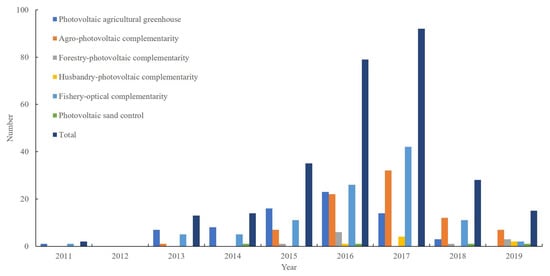
Figure 2.
Time distribution of the number of photovoltaic agricultural projects in different models [9].
For agro-photovoltaic complementarity systems in a region, the two factors that are important are which PA system and how to carry out smart agriculture practices within the PA system, especially plant protection measures for coping with plant diseases and pests. At present, with the continuous development of information and communications technologies and the shortage of cheap labor, there is an urgent need for sustainable and intelligent phytoprotection to achieve a more efficient way of plant protection. Therefore, we addressed new challenges and provided new opportunities while developing sustainable and intelligent phytoprotection in PA. It is important to consider sensor deployment in PA to monitor pests and diseases according to the Electromagnetic Interference (EMI) in PA. In this paper, we tested the optimal location for sensors within the PA systems.
The main contributions of this paper are as follows:
- (1)
- The key research challenges of sustainable and intelligent phytoprotection in PA were discussed, including the use of physical control equipment and wireless sensors.
- (2)
- In PA, wireless sensor nodes should not be deployed on the whole metal bracket where the confluence box is located. Deploying wireless sensor nodes at any position on this metal bracket will seriously affect the normal working state of Zigbee-based devices.
- (3)
- When nodes are deployed in PA, the connection between nodes also needs to be far from certain areas centered on the metal bracket where the confluence box is located. The Packet Reception Rate (PRR) will be affected if this connection passes through this area.
The rest of the paper is organized as follows. In Section 2, we present PA-related works. Phytoprotection applications and their requirements in PA are provided in Section 3. Then Section 4 presents a case study on factors influencing wireless communication quality on Zigbee-based devices in PA. Section 5 provides the current challenges and future research opportunities. Finally, Section 6 concludes the paper.
2. PA-Related Works
From the conclusion in [10], the optimal niche improvement path of PA in China includes the following six factors, technological innovation, policy formulation, resource allocation, economic improvement, social recognition, and environmental protection. Recently there have been many PA-related works, mainly about the innovative application of PA as a novel production mode [11]. However, there needs to be more evidence in support of the application of agricultural monitoring facilities in PA, much less the plant protection facilities in PA. Therefore, three factors are considered in this paper: (1) the coverage rate of photovoltaic panels, (2) the policy of photovoltaic land utilization, and (3) the absence of agricultural monitoring facilities.
2.1. The Coverage Rate of Photovoltaic Panels
The coverage rate of photovoltaic panels will determine the choice of either agricultural production or photovoltaic power generation.
When the coverage rate is no more than 50%, both agricultural production and photovoltaic power generation can be realized to some extent [12,13]. Therefore, before carrying out the Photovoltaic Agriculture project, it is necessary to consider the local environment, and the types of crops [14]. Forecasting models based on the satellite image-based photovoltaic power, the coverage rate of photovoltaic panels can be predicted [15].
There is also much research on thin-film photovoltaic cells with different light transmittance, which benefits plants’ growth under the panels. Due to conventional opaque photovoltaic modules causing a change in the microclimate under the panels, semi-transparent PV modules have been recently studied by considering the use of semi-transparent technologies based on crystalline silicon, thin-film photovoltaics, organic PVs, dye-sensitized solar cells, concentrating PVs, and luminescent solar concentrators [16]. Because there is still no significant advantage in manufacturing cost, the popularization and application of thin-film photovoltaic cells remain a significant challenge [17].
The environment in various regions shows great differences, where the crops that can be planted are also very different. The material of photovoltaic panels also affects the transmittance of the panel. All these factors make the determination of the coverage rate of photovoltaic panels face huge challenges.
2.2. The Policy of Photovoltaic Land Utilization
The policy change of photovoltaic land utilization will affect the types and output of plants planted in agricultural production [10].
Until 2021, China’s photovoltaic industry continued to triumph, with photovoltaic module output ranking first in the world for 15 consecutive years, polysilicon output ranking first in the world for 11 consecutive years, newly installed capacity ranking first in the world for 9 consecutive years, and cumulative installed capacity ranking first in the world for 7 consecutive years [18]. The vigorous development of the photovoltaic industry also means the constant policy adjustment of photovoltaic land utilization [19,20]. In the future, cultivated land should be occupied by something other than composite photovoltaic projects. Both sandy wasteland and saline-alkaline land are the potential choices for the photovoltaic projects, with power generation on the shed and animal husbandry under the shed.
Although sandy wasteland and saline-alkaline land are unrestricted as photovoltaic land utilization, there are significant challenges in engaging in agricultural production on such land.
2.3. Absence of Agricultural Monitoring Facilities
Due to the shielding effect of photovoltaic panels, loss from natural disasters, including intense light and hail, can be avoided, and a safe and stable growth environment can be provided for plants. At the same time, photovoltaic facilities will positively impact the ecological environment and climate of the region. However, due to the obstruction of the metal bracket, there needs to be more agricultural machinery with suitable size, especially in the area blocked by metal brackets under photovoltaic panels. This also leads to the need for manpower to complete the corresponding production operations, increasing the production cost.
- After deploying photovoltaic facilities in arid and desertification areas, the large-scale photovoltaic facilities improved the local microclimate and soil temperature and humidity between photovoltaic arrays, which increased the local plant coverage and carbon sequestration potential [21]. Therefore, after the establishment of photovoltaic power stations in northwest China, there is more and more forage grass under photovoltaic facilities, enough to support animal husbandry.
- For saline-alkaline land, except for highly severe saline-alkaline land and land plots with large topographic relief, they can be improved by engineering and agronomic measures to become farmland or land for agricultural facilities construction. Following the above principles on saline-alkaline land, grass planting, oat planting, well drilling and rice planting are selected for land improvement, and utilization [22]. Land improvement can combine favorable environmental and climate changes to produce a better effect.
Generally speaking, after photovoltaic projects are carried out in the sandy wasteland, saline-alkaline land, the planting environment can be gradually improved in the next few years, which is of great help to improve the economic benefits of agricultural production. At the same time, it is necessary to adjust agricultural production parameters according to actual environmental conditions. There still needs to be more technology and equipment suitable for agricultural monitoring and plant protection in PA.
3. Photovoltaic Agriculture: Phytoprotection Applications and Their Requirements
3.1. Concept of Sustainable and Intelligent Phytoprotection
As a new interdisciplinary subject, it emerged under the background of the continuous development of science and technology and the in-depth integration of information technology into the field of plant protection. Traditional plant protection disciplines focus on life disciplines such as chemistry, biology and ecology, and based on this, research is carried out to reduce pesticide pollution, protect the environment, and realize sustainable ecological development. At present, information and communication technologies are rapidly developing and emerging technologies, including the Internet of Things, satellite remote sensing, aerial images, Big Data, cloud computing, Artificial Intelligence, and Blockchain, have received extensive attention from researchers in the agricultural field and promoted an in-depth integration of these technologies. These emerging technologies can also provide new research ideas and solutions for plant protection, thus realizing “sustainable and intelligent phytoprotection” [23]. Based on the above technologies, with smartphones, computers, robots, drones, and various agricultural machinery or equipment as terminals, this subject is used for pest monitoring, forecasting and early warning, prevention and control and management [24].
3.2. Why Carry Out Sustainable and Intelligent Phytoprotection in PA?
Table 1 “Comparison of different agricultural internet of things” in [2], compared with the traditional agricultural IoT and greenhouse IoT, remote sensing technology and drone are unavailable for information acquisition in PAIoT due to the photovoltaic panels and the metal bracket. Therefore, sensors need to be used in PA to collect the information to draw up the decisions, including the operating time of fertilization, spraying and harvesting. Otherwise, the plants will suffer from malnutrition and pest and disease, eventually leading to reduced production. Therefore, based on the labor force reduction and information technology improvement, it is necessary to carry out sustainable and intelligent phytoprotection in PA.
3.3. How to Carry Out Sustainable and Intelligent Phytoprotection in PA?
Due to the metal bracket of PA, which obstructs drone flying, and the photovoltaic panels obstructing satellite monitoring, the development of the complementary agricultural project needs to face the severe challenge of the lack of plant protection. In addition, pesticides from agricultural machines easily fall on photovoltaic panels, which may affect the power generation efficiency of photovoltaic panels if pesticides are not cleaned in time. So, chemical control in plant protection measures is hard to realize by agricultural machines, e.g., drones, in PA, while physical control, biological control, and ecological control can be applied.
The land in PA can be divided into ordinary farmland, sandy wasteland, and saline-alkaline land.
For ordinary farmland (Figure 1b):
- Physical control: The Solar Insecticidal Lamp (SIL), as a representative physical control equipment, can be deployed on the metal bracket under the photovoltaic panel, effectively reducing the deployment cost. The SIL, equipped with a camera and a temperature and humidity sensor, can be deployed to monitor plant diseases and pests in the area around SIL. Moreover, the environmental condition parameters in PA can also be collected, further judging the occurrence law of pests and diseases.As shown in Figure 3, the application mode of SIL in PA is as follows:
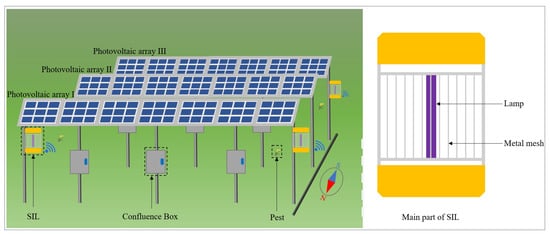 Figure 3. The Solar Insecticidal Lamps in PA.
Figure 3. The Solar Insecticidal Lamps in PA.- (1)
- In the daytime, photovoltaic panels generate electricity, part of which charges the storage battery of the SIL, and part of which is connected to the grid to sell electricity. The air temperature and humidity sensor, soil moisture sensor, soil fertility sensor, and camera on the SIL are to collect the environmental condition data, pests and diseases in PA. SIL nodes communicate with each other through wireless sensor networks, and the data is transmitted to the base station for analysis to draw up further plant protection measures in this area.
- (2)
- In the nighttime, the metal mesh of SIL discharges to kill pests, and the insecticidal quantity is recorded to analyze the active time of different pests, further acquiring the law of their active time. The time for SIL killing the pests is up to the results about the active time of both pests and beneficial insects in PA, thus decreasing the number of beneficial insects killed.
- Biological control: Biological control can be carried out according to the above law of the active time of different pests. Furthermore, the impact of various factors, e.g., environmental conditions, host plants, host pests, application methods, and product batches, on natural enemies of pests and pathogenic microorganisms is taken into consideration, further realizing green intelligent biological control.
- Ecological control: Ecological control can also be carried out. According to the current environmental conditions in PA, some kinds of crops can be determined so that the crops can be in a suitable growth environment, thus improving the disease resistance of crops. Furthermore, the planting structure of crops can be continuously improved, beneficial organisms can be protected, and the occurrence rate of pests and diseases can be controlled through biodiversity regulation.
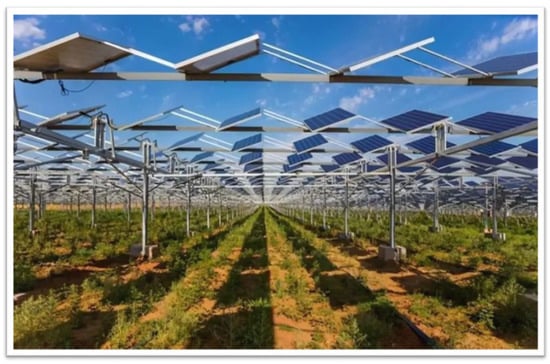
Figure 4.
The saline-alkaline land in PA (Cixi City, Zhejiang, China).
- Carrying out photovoltaic projects on these two kinds of land, photovoltaic panels will improve local climate conditions, positively affecting land improvement. At the beginning of the project, environmental monitoring sensors are deployed to monitor the changes in environmental condition parameters in PA and decide whether to plant crops and what kinds of crops to plant according to the environmental condition parameters. With the gradual improvement of the land, the variety of crops that can be planted increases, and the corresponding pests and diseases also change. At this time, the land could be treated as ordinary farmland.
3.4. Considerations for Phytoprotection Requirements
Through the description of research problems in both Photovoltaic Agricultural Internet of Things (PAIoT) [2] and Solar Insecticidal Lamps Internet of Things (SIL-IoTs) [26], there are common research problems in these two agricultural Internet of Things:
- (1)
- Deployment of physical control equipment: Due to the influence of the inverter and other equipment, the wireless communication in PA will be affected by EMI. The strong electromagnetic pulse generated by the SIL during the insecticidal discharge will seriously interfere with the communication equipment around it and even lead to equipment failure. Therefore, to reduce the interference on deployed equipment in PA, deployment can be carried out as far as possible to avoid the interference area, and at the same time, wireless communication equipment and sensors are not deployed within 25 cm around the SIL [27].
- (2)
- Deployment of monitoring sensors: Monitoring environmental parameters is vitally important for understanding the occurrence law of diseases and pests in this area and what kind of crops are suitable for planting. In order to monitor the change of environmental parameters in PA, it is necessary to deploy air temperature, humidity, and soil moisture sensors, which can also be integrated into the nearby SIL.
To sum up, for the above-mentioned joint research issues, the critical point lies in figuring out which areas are suitable for deploying SIL nodes in PA. Thus, it is necessary to carry out practical experiments in PA.
4. Case: Influencing Factors of Wireless Communication Quality on Zigbee-Based Devices in PA
4.1. Experimental Setup
4.1.1. Experimental Scenario
The experimental scenario of PA and the two kinds of testbeds are shown in Figure 5.
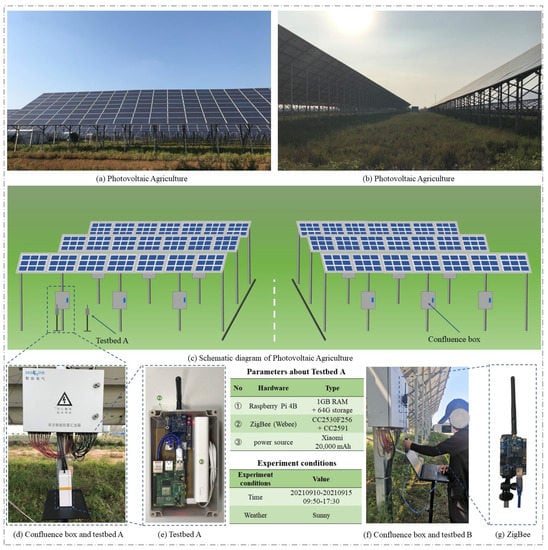
Figure 5.
The scenario of PA and the testbeds.
- (1)
- Introduction
Experimental location: Shandong Chengye Agricultural Science and Technology Co., Ltd. (37 1948.2 N 116 2851.7 E), South Ring, Dezhou, Shandong Province, China.
PA: Power generation occurs on the photovoltaic panel, and planting and breeding are under the photovoltaic panel. Each column of the photovoltaic array in the vertical direction consists of 8 photovoltaic panels, and the number of photovoltaic panels in the horizontal direction is up to the site constraints. The model of the photovoltaic panel is ZXP6-60-260/P, the maximum power of each photovoltaic panel is 260 W (0 +3%), and the weight/size information of each photovoltaic panel is 19.5 kg/1640 mm × 992 mm × 35 mm.
The plants growing under the photovoltaic panel include Sonchus arvensis L. and Suaeda prostrata Pall., which can be used as forage for goats. In PA, the height of plants can be monitored by the parameter RSSI [28], and then goats can be reasonably fed according to the height of plants in different areas.
- (2)
- Deployment of experimental devices
The metal bracket under the photovoltaic panel is suitable for deploying sensors and other equipment. Considering the convenience of the experiment, the nodes are put on the tripod next to the metal bracket.
- (3)
- Selection of communication protocol
On the one hand, when the PA was designed, no interface was reserved to supply power for the sensors deployed in PA. On the other hand, if the power supply interface is reserved, the power of sensors comes from solar energy directly, but the solar energy is so unstable that the performance of the sensors may need to be guaranteed. Therefore, wireless sensor nodes with independent power supplies are deployed in this PA.
Considering the amount of energy consumption, high-energy devices based on WiFi and 5G are unsuitable. Meanwhile, according to the pitch of photovoltaic arrays and the number of nodes to be deployed in PA, LoRa and Bluetooth-based devices should not be considered. Therefore, ZigBee is selected as the communication protocol here, which can meet the demand of low power consumption and realize a large-scale ad hoc network.
The data transmission format in the experimental bed is as follows: (One packet is sent every 0.1 s, and each packet has the same content. The PRR is counted every 10 s.)
“2021-09-11 13:31:51.004=@AA.BB.CC.000$-43#”
in which,
- 2021-09-11 13:31:51.104: it means data sending time;
- AA.BB.CC.000: it means data details;
- -43: it means RSSI.
4.1.2. Testbeds
Based on the experimental requirements of long-term monitoring and real-time data viewing, two different experimental beds [27] are adopted in this paper, both of which can keep the same function and parameter settings.
- (1)
- Testbed A
The testbed A comprises Raspberry Pi, ZigBee module, and power, as shown in Figure 5e. As depicted in Figure 6b, the power supplies the energy to both Raspberry Pi and ZigBee modules. After collecting the data from the ZigBee module, data is stored in the SD card of Raspberry Pi.
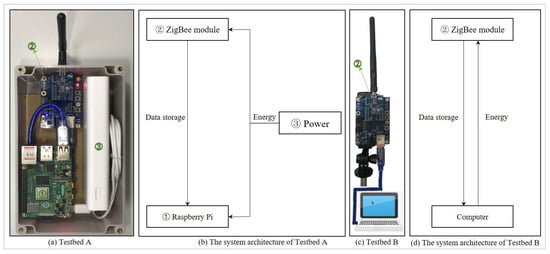
Figure 6.
The testbeds in the experiments.
The testbed A is placed in a position to perform a long-term monitoring experiment. The data can be obtained through the WiFi-based device temporarily deployed nearby. However, during the period of data acquisition, the data may show new changes. Therefore, testbed A must wait to meet the data viewing requirements in time.
After the data collected from 2021/9/11 13:30:11 to 16:07:41, we can draw Figure 7 about PRR change with time. If it exhibits a big change, it means that around the testbed, there is interference, such as the value of PRR marked in the red box. We can also draw Figure 8 about CRC_error change with time and Figure 9 about RSSI change with time, both of which are set to indicate the existence of interference originally. However, they could have worked more obviously and stably as PRR changed with time. So PRR change with time is chosen as the main result in the following experiments.
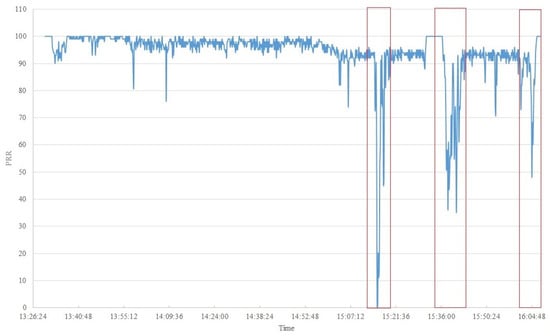
Figure 7.
PRR change with time.
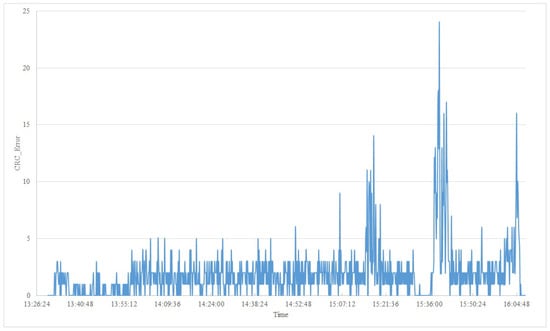
Figure 8.
CRC_error change with time.
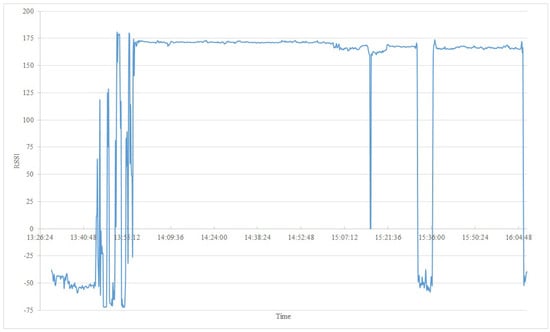
Figure 9.
RSSI change with time.
- (2)
- Testbed B
The testbed B comprises a ZigBee module and computer, as shown in Figure 5f. As depicted in Figure 6d, the computer supplies the energy to the ZigBee module. After collecting the data from the ZigBee module, data is stored in the disk of the computer.
Testbed B is directly connected to the computer, which can quickly acquire and present data on the computer’s screen. The experimenter can move testbed B through the bracket and synchronously observe the data change to quickly judge the experimental effect. If the data is missing at a certain moment, it means that the data packet has not been received at that moment. Considering this characteristic of testbed B, it is suitable for pre-experiment.
4.2. Experimental Scheme
According to the coordinates in Table 1, Table 2 and Table 3, the receiving node and the sending node were deployed in PA (depicted in Figure 10). People should stay away from the node whenever the node is deployed to ensure that the data transmission is not blocked. The data transmission time is set to at least 1 min to fulfill the requirement of displaying on the computer’s screen. Then move the nodes to the next position in the tables and continue the experiments.

Table 1.
Controlled experiments scheme on the power of 0 dBm.

Table 2.
Transmission experiments scheme on the power of 0 dBm.

Table 3.
Transmission experiments scheme on the power of 21 dBm.
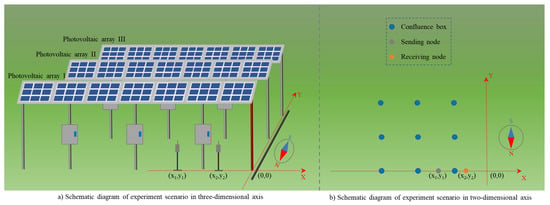
Figure 10.
Schematic diagram of node’s position in PA.
Currently, the research on anti-Electromagnetic Interference is carried out based on the three elements of EMI source, transmission path, and sensitive equipment, involving key measures such as increasing distance [29], filtering technology [30], shielding design, and grounding design. According to the research result in [31], wireless devices can work stably when installed at a certain distance away from the photovoltaic panel and the inverter. Therefore, in the experiments carried out in this paper, similar operations can be arranged to reduce the influence of EMI.
Table 1 shows whether the PRR of the receiving node is affected. The purpose of these experiments is to verify the existence of EMI in PA.
- In the experiments with the No from 1 to 4, move the receiving node to change the distance between the receiving node and the confluence box.
- In the experiment with the No 5, move the sending node and the receiving node simultaneously to stay away from the confluence box.
- In the experiments with the No from 6 to 8, move the sending node to change the position of both the sending node and the receiving node and to change the distance between the receiving node and the confluence box.
- In the experiment with the No 9, move the sending node and the receiving node away from the confluence box simultaneously.
Table 2 shows whether the PRR of the receiving node is affected. The purpose of these experiments is to determine the area where EMI exists.
- In the experiments with the No from 1 to 4, move the receiving node to change the distance between the receiving node and the confluence box.
- In the experiment with No 5, move the sending node to the other side of the metal bracket under the photovoltaic panels, and at the same time, move the receiving node so that the connection line between the sending and receiving nodes does not pass through the confluence box.
- In the experiments with the No from 6 to 7, fix the position of the receiving node and move the sending node to the neighbor metal bracket of the same photovoltaic array.
- In the experiments with the No from 8 to 11, exchange the positions of the sending node and the receiving node corresponding to the experiments with the No from 1 to 4.
- In the experiments with the No from 12 to 14, which is different from the experiments with the No from 5 to 7, move the sending node so that the confluence box can appear on the connection line between the sending and receiving nodes.
Table 3 shows whether the PRR of the receiving node is affected. These experiments aim to study the change law of communication quality under the conditions of different transmitting and receiving power. The experimental position is the same as those in Table 2, but the node power used in the experiment in Table 3 is 21 dBm, which is significantly higher than those in Table 2, to observe the influence of node power on the receiving node’s PRR in the interference environment.
4.3. Experimental Results and Analysis
4.3.1. Controlled Experiments on the Power of 0 dBm
As shown in Figure 11, the whole broken line shows the change of PRR with time, and different colors from label 0 to label 9 show different meanings as follows:
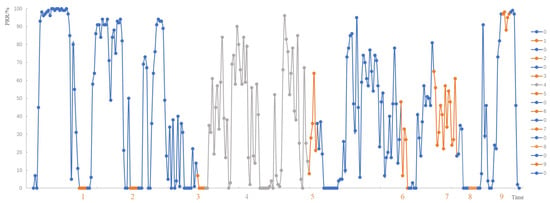
Figure 11.
The curve of PRR in the controlled experiments on the power of 0 dBm.
- Label 0: It is the collected data while moving the nodes;
- Label 1 to 3: When the receiving node is deployed on the metal bracket near the confluence box, the PRR is very low or even zero;
- Label 4: When the receiving node moves up and down on the metal bracket where the confluence box is located, the PRR also fluctuates significantly, and the PRR is even zero sometimes;
- Label 5: When the sending node and the receiving node synchronously move to the position far away from both the photovoltaic array and the confluence box, the PRR improved;
- Label 6: When the sending node is deployed again on the metal bracket near the confluence box, the PRR is not zero;
- Label 7: When the sending node moves to the metal bracket where the confluence box is located, the PRR is not zero;
- Label 8: When there is a confluence box between the sending node and the receiving node, the PRR is zero;
- Label 9: When the sending node and the receiving node synchronously move away from both the photovoltaic array and the confluence box, the PRR recovers to a high value.
Through the above continuous experiments, the confluence box will seriously affect the PRR of the receiving node, and the PRR will even drop to zero. Moreover, if there is a confluence box between the sending node and the receiving node, the PRR of the receiving node will be seriously affected.
In addition, through long-term experimental monitoring, the PRR is not always zero at the same position because the intensity of EMI changes with the environment parameters (e.g., mainly the light intensity, which changes all the time and leads to the current change during the power generation). Thus, it is difficult to reproduce the stable PRR at the above-mentioned fixed position. It also means that it is suitable to carry out qualitative research on wireless communication quality experiments in PA. Compared with the change of PRR, the change of both CRC_error and RSSI is not so significant that they are not shown here.
Therefore, it can be explained that the confluence box is one EMI source in PA, and the sensor node cannot be deployed nearby the confluence box. Otherwise, the PRR will be significantly affected. When there is a confluence box between the sending node and the receiving node, whether the confluence box will impact the PRR of the receiving node needs further verification by the following experiments.
4.3.2. Transmission Experiments on the Power of 0 dBm
As shown in Figure 12, the whole broken line shows the change of PRR with time, and different colors from label 0 to label 14 show different meanings as follows:
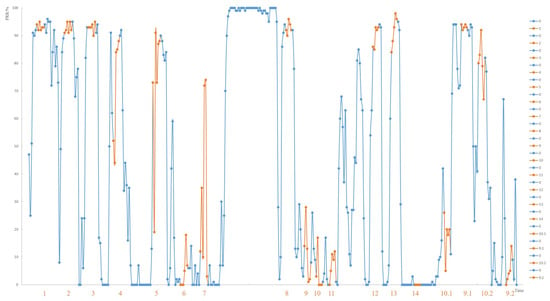
Figure 12.
The curve of PRR in the transmission experiments on the power of 0 dBm.
- Label 0: It is the collected data while moving the nodes;
- Label 1 to 2: There is no confluence box on the connecting line between the sending node and the receiving node. When the receiving node is gradually moved forward to the confluence box, and the PRR does not fluctuate significantly;
- Label 3: There is a confluence box on the connecting line between the sending node and the receiving node, and the PRR does not fluctuate significantly;
- Label 4: There is a confluence box on the connecting line between the sending node and the receiving node. Compared with the experiment in “Label 3”, the receiving node is far away from the confluence box, and the PRR fluctuates significantly;
- Label 5 to 7: There is no confluence box on the connecting line between the sending node and the receiving node, and the receiving node is 6m away from the confluence box. When the sending node is gradually moved forward to the receiving node, the PRR fluctuates, indicating that the PRR is also affected by factors other than the distance;
- Label 8 to 9: There is no confluence box on the connecting line between the sending node and the receiving node. The sending node in “Label 9” is closer to the confluence box than that in “Label 8”, then the PRR drops greatly;
- Label 10 to 11: A confluence box is on the connecting line between the sending node and the receiving node. When the sending node is moved away from the confluence box, the PRR is low;
- Label 12–14: There is a confluence box on the connecting line between the sending node and the receiving node. The position of the sending node is unchanged. When the receiving node is gradually moved away from the confluence box, the PRR is reduced from a high value to zero;
- Label 10.1, 9.1, 10.2, 9.2: The experiments were repeated twice at the positions in “Label 10” and “Label 9”, and the PRR exhibited a significant difference. Combined with the conclusion of the controlled experiments, it can be assumed that there is an area of EMI near the confluence box. If the receiving and sending nodes are deployed in this area, the PRR will be affected. The closer to the confluence box, the greater the interference effect. Therefore, if the sending node and the receiving node with the power of 0 dBm are deployed on the metal bracket within the area which is 6 m away from the confluence box, the PRR of the receiving node will still be affected.
When the power of both the sending node and the receiving node increases, whether the confluence box will impact the PRR of the receiving node needs further verification by the following experiments.
4.3.3. Controlled Experiments on the Power of 21 dBm
Perform the experiments on the power of 21 dBm in the same position as that in the experiments on the power of 0 dBm.
As shown in Figure 13, the whole broken line shows the change of PRR with time, and different colors from label 0 to label 14 show different meanings as follows:
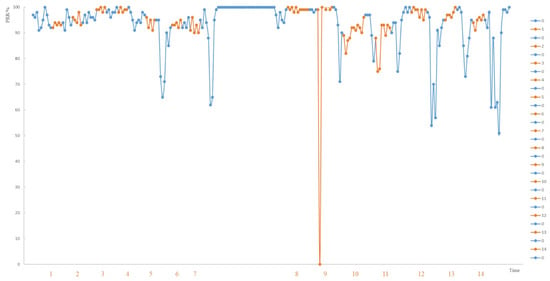
Figure 13.
The curve of PRR in the transmission experiments on the power of 21 dBm.
- Label 1 to 8, 10 to 14: The PRR is high without violent fluctuation;
- Label 9: When there is a confluence box on the connecting line between the sending node and the receiving node, the PRR will still be affected. Overall, the negative effect is less than 0 dBm at the cost of increasing node energy consumption.
Through the above experiments on the power of 21 dBm, it is further illustrated that the deployment of the sending node and the receiving node should be as far away from the confluence box as possible. The connecting line between them should not pass through the confluence box and should be as far away from the confluence box as possible, further reducing the impact of EMI on PRR.
4.4. Experimental Discussion
Through these three experiments, it can be found that carrying out experiments in the same position cannot get the same results. Because EMI is affected by environmental factors such as light intensity, EMI in PA exhibits random characteristics, which also leads to different influences on the PRR of nodes. Therefore, it is suitable for qualitative analysis based on the experimental results.
4.5. Experimental Conclusions
In deploying wireless sensor nodes, only some of the metal brackets of PA are suitable for fixing the nodes, and the wireless sensor nodes should not be deployed at any position on the whole metal bracket where the confluence box is located. In addition, for a certain area around the metal bracket where the confluence box is located, when the connecting line between the sending node and the receiving node passes through this area, the PRR of the receiving node will suffer a negative impact.
5. Current Challenges and Future Research Opportunities
Due to the obstruction of the metal bracket, chemical control for pests and diseases by drones is facing significant challenges in PA. Therefore, more measures, including physical, ecological, and biological control, will be adopted for plant protection in PA. Taking SIL as a physical control example, when the pests are killed by high voltage from the metal mesh of SIL, count the pest density in the area covered by the SIL and transmit this data to the base station by wireless sensor networks, further acquiring the pest density distribution in PA and providing the data support for biological control and ecological control. Based on the above analysis, the new challenges and future research opportunities for sustainable and intelligent phytoprotection in PA are as follows:
5.1. SIL Deployment Strategy in PA
At present, the physical prevention and control equipment for pests includes entomological radar, high altitude forecast lamp, insect situation forecast lamp, SIL, sex pheromone lamp, sticky insect board, and so on. For the deployment of physical prevention and control equipment, the existing research mainly focuses on the SIL deployment [32,33,34]. The deployment constraint conditions include full coverage, full connectivity of the network, node deployment location constraints, and nonuniform deployment environment constraints. The deployment optimization objectives include maximizing the overlap rate, and maximizing the total network weight. However, the scenario characteristics of the six PA modes are quite different where the deployment constraint conditions need to be updated.
- The deployment strategy of SILs in photovoltaic agricultural greenhouses needs to consider the size limitation of the greenhouse.
- The deployment strategy of SILs in forestry-photovoltaic complementarity needs to consider the constraints of topography and geomorphology.
- In the fishery-optical complementarity, the insecticidal lamp without metal mesh can be deployed, and the pests fall into the water after colliding with the lamp, further being food for fish. This structure of the insecticidal lamp is simple and the cost is cheap, so we can improve the deployed insecticidal lamp quantity under the same budget, thereby reducing the loss of crops around the water area by pests.
- For the agro-photovoltaic complementarity, husbandry-photovoltaic complementarity, and photovoltaic sand control, according to the previous experimental conclusions, it is not suitable to deploy wireless sensor network nodes in the area where the confluence box is located. In addition, the installed capacity should also be taken into consideration, which is related to the size of the above area.
5.2. Environmental Sensors Deployment Strategy in PA
To monitor environmental conditions in PA, it is necessary to consider the environmental sensors deployment strategy in the following five aspects.
- The climate in PA will change due to the shading effect of photovoltaic panels. Taking agro-photovoltaic complementarity, husbandry-photovoltaic complementarity, and photovoltaic sand control as examples, the transpiration of the soil below is weakened, and the soil moisture content is increased, which is beneficial to plant growth and the outbreak of plant diseases and pests. Therefore, it is necessary to monitor the changes in climate in PA and provide long-term data support for the outbreak law of plant diseases and pests in PA.
- The lighting conditions in PA will change due to the shading effect of photovoltaic panels. The coverage rate of photovoltaic panels directly affects the plant species planted in PA. Furthermore, the light will impact the insects [35]. For insects active in the daytime, photovoltaic panels can prevent insects from being burned by strong light in summer and provide a more suitable habitat for their reproduction. For insects active at night, insecticidal lamps with different wavelengths will attract different kinds of insects, and a reasonable selection of the lamp can effectively reduce the number of beneficial insects killed [36].
- The electromagnetic environment will change due to the power generation equipment in PA. The migration of insects is influenced by the direction and intensity of the magnetic field [37], and the magnitude of the earth’s magnetic field is between 0.03 and 0.06 mT, while the standard of the magnetic field intensity of electromagnetic radiation in PA is not more than 0.1 mT [38]. Therefore, the magnetic field intensity in PA may exceed that of the earth, which will inevitably affect the growth and development, phototaxis and flight behavior, reproduction and behavior, and life span of insects, thus the pest control measures need to be adjusted accordingly [39,40,41].
- After a large number of different monitoring equipment is deployed in PA, it involves the task allocation of manual post-maintenance and data collection. How to reduce the maintenance cost by adjusting the deployment strategy is also a key issue [42,43].
- The deployment density of different monitoring sensors is not the same, so it is necessary to take into account the monitoring requirements for different parameters and carry out the sensor deployment strategy differently. For sensors integrated on the SIL, it is not suitable to deploy the wireless sensor network node near the metal mesh 25 cm to avoid the interference of EMI generated from high voltage discharge [27].
5.3. Adaptive Adjustment Strategy of Data Transmission in PA
Under different weather conditions, the development of plant diseases and pests in PA is also different, and the data transmission strategy for plant diseases and pests, including the selection of transmission time and the transmission time period, also needs to be adjusted according to the current weather conditions.
The power generation efficiency is different under various weather conditions during the day, and the interference generated during the power generation will impact the process of transmitting data. The high-voltage discharge will produce strong EMI, so the time period for data transmission in PA should also avoid high-voltage discharge intensive periods.
5.4. Special Design on Equipment Stability in PA
In PA, equipment is prone to failure in an environment with high temperatures and high humidity for a long time, which affects the stable work of equipment and reduces its service life. If the equipment can carry out fault diagnosis and self-check some problems with special design on equipment stability, it will greatly reduce the maintenance cost of the equipment [44,45,46].
In addition, improving the stability of equipment in PA will be recognized by more users, which is conducive to the popularization and application of sustainable and intelligent phytoprotection in PA.
5.5. New Equipment and Technology for Forecasting Pests and Diseases in PA
Because the environment in PA is significantly different from that in traditional agriculture and traditional greenhouses, it is necessary to redesign the equipment for forecasting and controlling plant diseases and pests.
- The existing insect situation forecast lamp is expensive, and its function cannot meet the needs of pest monitoring in different time periods, thus its popularization and application are limited. It is necessary to develop an insect situation forecast lamp with diversified functions.
- Compared with the SILs fixedly installed in PA, the unmanned aerial vehicle insecticidal lamp is flexible and provides effective support for pest control [47,48].
6. Conclusions and Future Scope
6.1. Conclusions
As one of the novel agricultural production models in the future, PA exhibits a bright prospect. The applications of PAIoTs will facilitate exponential growth in the agricultural IoT field. With the continuous development of PA, the land available for photovoltaic projects has become a constraint. Taking sandy wasteland and saline-alkaline land as examples to develop photovoltaic projects, the time slot of agricultural production’s income is later than that on normal farmland. Furthermore, the lack of appropriate plant protection measures will also make PA face more significant losses caused by pests and diseases. Thus, with the combination of PAIoT and SIL-IoTs, sustainable and intelligent phytoprotection in PA is proposed. Based on phytoprotection applications and their requirements for environmental parameters, a series of experiments are designed and performed by testbeds A and B to verify their functional stability. In the actual process of deploying wireless sensor nodes, only some of the metal brackets of PA are suitable for fixing the nodes, and the wireless sensor nodes should not be deployed at any position on the whole metal bracket where the confluence box is located. In addition, for a certain area with a radius of 6 m centered on the confluence box, when the connecting line between the sending node and the receiving node passes through this area, the PRR of the receiving node will suffer a negative impact and even zero. These will be the constraint conditions for the wireless sensor nodes’ deployment in PA, indicating the new challenges and future research opportunities in PA.
6.2. Future Scope
For future scope, we plan to conduct further research about sustainable and intelligent phytoprotection in the following six aspects.
- (1)
- Sustainable and intelligent pest identification and control in PA;
- (2)
- Green intelligent biological control technology in PA;
- (3)
- Green intelligent ecological control technology in PA;
- (4)
- Scientific breeding and quality control technology in PA;
- (5)
- Green smart and scientific pesticide application technology in PA;
- (6)
- Intelligent weather disaster prevention technology in PA.
Author Contributions
Conceptualization, K.H., L.S., K.L., Y.C. and Y.Z.; Methodology, K.H., K.L. and Y.C.; Software, K.H. and K.L.; Validation, K.H., K.L. and Y.C.; formal analysis, K.H., K.L. and Y.C.; investigation, K.H., K.L. and Y.C.; resources, K.H., K.L. and Y.C.; data curation, K.H., K.L. and Y.C.; writing—original draft preparation, K.H. and Y.C.; writing—review and editing, K.H., L.S., K.L., Y.C., Y.Z., and R.V.; visualization, K.H., K.L. and Y.C.; supervision, K.H., L.S., K.L., Y.C. and Y.Z. All authors have read and agreed to the published version of the manuscript.
Funding
This research was funded by Future Network Scientific Research Fund Project grant number FNSRFP-2021-YB-08.
Data Availability Statement
Not applicable.
Conflicts of Interest
All authors declare no conflict of interest.
References
- Yi, X.; Li, X.; Sheng, B.; Yang, H.; Cao, B.; Xu, P. Impact of Russia–Ukraine Conflict on International Economic and Trade Landscape. Int. Econ. Rev. 2022, 3, 9–37. [Google Scholar]
- Huang, K.; Shu, L.; Li, K.; Yang, F.; Han, G.; Wang, X.; Pearson, S. Photovoltaic Agricultural Internet of Things towards Realizing the Next Generation of Smart Farming. IEEE Access 2020, 8, 76300–76312. [Google Scholar] [CrossRef]
- Photovoltaic Agricultural Greenhouses Benefit Farmers in Zhejiang, E China. Available online: http://www.xinhuanet.com/english/2018-05/27/c_137210458.htm (accessed on 19 January 2023).
- Understanding the Impact of Dual-Use Solar-Agriculture Installations in Massachusetts. Available online: https://www.cns.umass.edu/news-events/news/understanding-impact-dual-use-solar-agriculture-installations-massachusetts (accessed on 19 January 2023).
- Forestry-Photovoltaic Complementarity Project Helps Rural Revitalization in Wujiang. Available online: https://www.sohu.com/a/504949995_120099883 (accessed on 19 January 2023).
- Husbandry-Photovoltaic Complementarity Project Realizes Ecological Enrichment. Available online: http://www.gonghe.gov.cn/html/1808/608571.html (accessed on 19 January 2023).
- In Fishery-Optical Complementarity Project, Power Is Generated above and Fishes Are Raised below. Available online: http://www.nanxunfb.com/xzsm/202003/t20200331_1409046.html (accessed on 19 January 2023).
- The Destruction of Dunhuang Shelterbelt Attracts Attention to Photovoltaic Sand Control and Creates a New “Oasis” in the Desert. Available online: https://www.origin-se.com/newsinfo/1128819.html (accessed on 19 January 2023).
- Chen, J.; Wang, L. The Development Stage and Regional Distribution of Photovoltaic Agriculture in China. J. Anhui Agric. Sci. 2022, 50, 246–249. [Google Scholar]
- Wang, L.; Li, Y. Research on Niche Improvement Path of Photovoltaic Agriculture in China. Int. J. Environ. Res. Public Health 2022, 19, 13087. [Google Scholar] [CrossRef]
- Fu, X.; Niu, H. Key Technologies and Applications of Agricultural Energy Internet for Agricultural Planting and Fisheries Industry. Inf. Process. Agric. 2022. [Google Scholar] [CrossRef]
- Wang, Y.; Wei, X. Advance on the Effects of Different Light Environments on Growth, Physiological Biochemistry and morphostructure of Plant. J. Mt. Agric. Biol. 2010, 29, 353–359. [Google Scholar]
- Touil, S.; Richa, A.; Fizir, M.; Bingwa, B. Shading Effect of Photovoltaic Panels on Horticulture Crops Production: A Mini Review. Rev. Environ. Sci. Bio/Technol. 2021, 20, 281–296. [Google Scholar] [CrossRef]
- Cho, J.; Park, S.M.; Park, A.R.; Lee, O.C.; Nam, G.; Ra, I.-H. Application of Photovoltaic Systems for Agriculture A Study on the Relationship between Power Generation and Farming for the Improvement of Photovoltaic Applications in Agriculture. Energies 2020, 13, 4815. [Google Scholar] [CrossRef]
- Si, Z.; Yang, M.; Yu, Y.; Ding, T. Photovoltaic Power Forecast Based on Satellite Images Considering Effects of Solar Position. Appl. Energy 2021, 302, 117514. [Google Scholar] [CrossRef]
- Gorjian, S.; Bousi, E.; Özdemir, Ö.E.; Trommsdorff, M.; Kumar, N.M.; Anand, A.; Kant, K.; Chopra, S.S. Progress and Challenges of Crop Production and Electricity Generation in Agrivoltaic Systems using Semi-transparent Photovoltaic Technology. Renew. Sustain. Energy Rev. 2022, 158, 112126. [Google Scholar] [CrossRef]
- Jiang, H. Forecast of Development Trend of PV Power Generation Technologies in the Future. Sol. Energy 2022, 1, 5–13. [Google Scholar]
- Wang, Q.; Sun, Y.; Zhang, H.; Ru, J.; Jiang, H. Review of China Photovoltaic Industry in 2021 and Prospect in 2022. Electr. Age 2022, 5, 20–28. [Google Scholar]
- Notice on Land Utilization Control Index of Photovoltaic Power Station Project from Ministry of Natural Resources of the People’s Republic of China. Available online: http://f.mnr.gov.cn/201703/t20170329_1447083.html (accessed on 19 January 2023).
- Opinions on Supporting Photovoltaic Poverty Alleviation and Standardizing Land Utilization of Photovoltaic Power Generation Industry. Available online: http://f.mnr.gov.cn/201710/t20171010_1609304.html (accessed on 19 January 2023).
- Wu, C.; Su, Z.; Liu, H.; Zhao, W.; Yu, H. Eco-hydrological Effects of Photovoltaic Power Generation Facilities on Dryland Ecosystems: A Review. Plateau Meteorol. 2021, 40, 690–701. [Google Scholar]
- Gao, M.; Tian, Z.; Gao, F.; Tan, H.; Mu, N.; Wang, J.; Zhao, Z. Research on “Photovoltaic+Agriculture” Development Model of Saline-alkaline Land in Western Jilin Province. Anhui Agric. Sci. Bull. 2019, 25, 156–158. [Google Scholar]
- Huang, K.; Shu, L. Grand Challenges in Sustainable and Intelligent Phytoprotection. Front. Plant Sci. 2021, 12, 2513. [Google Scholar] [CrossRef] [PubMed]
- Wang, H. Smart phytoprotection and suggestions for its development. J. China Agric. Univ. 2022, 27, 1–21. [Google Scholar]
- Photovoltaic Agriculture: Turning Saline-alkaline Land into “Jinshan Yinshan”. Available online: https://new.qq.com/rain/a/20220916A06OOM00 (accessed on 19 January 2023).
- Li, K.; Shu, L.; Huang, K.; Sun, Y.; Yang, F.; Zhang, Y.; Huo, Z.; Wang, Y.; Wang, X.; Lu, Q.; et al. Research and Prospect of Solar Insecticidal Lamps Internet of Things. Smart Agric. 2019, 1, 13–28. [Google Scholar]
- Huang, K.; Li, K.; Shu, L.; Yang, X.; Gordon, T.; Wang, X. High Voltage Discharge Exhibits Severe Effect on ZigBee-based Device in Solar Insecticidal Lamps Internet of Things. IEEE Wirel. Commun. 2020, 27, 140–145. [Google Scholar] [CrossRef]
- Bauer, J.; Aschenbruck, N. Towards a Low-cost RSSI-based crop monitoring. ACM Trans. Internet Things 2020, 1, 1–26. [Google Scholar] [CrossRef]
- Batista, N.C.; Melício, R.; Matias, J.C.O.; Catalão, J.P.S. Photovoltaic and Wind Energy Systems Monitoring and Building Home Energy Management using ZigBee Devices within a Smart Grid. Energy 2013, 49, 306–315. [Google Scholar] [CrossRef]
- Zhu, B.; Leskarac, D.; Lu, J.; Wishart, M. Electromagnetic Interference Investigation of Solar PV System for Microgrid Structure. In Proceedings of the 7th Asia Pacific International Symposium on Electromagnetic Compatibility, Shenzhen, China, 17–21 May 2016. [Google Scholar]
- Toledo, C.; Serrano-Lujan, L.; Abad, J.; Lampitelli, A.; Urbina, A. Measurement of Thermal and Electrical Parameters in Photovoltaic Systems for Predictive and Cross-Correlated Monitorization. Energies 2019, 12, 668. [Google Scholar] [CrossRef]
- Yang, F.; Shu, L.; Huang, K.; Li, K.; Han, G.; Liu, Y. A Partition-Based Node Deployment Strategy in Solar Insecticidal Lamps Internet of Things. IEEE Internet Things J. 2020, 7, 11223–11237. [Google Scholar] [CrossRef]
- Yang, F.; Shu, L.; Yang, Y.; Liu, Y.; Gordon, T. Improved Coverage and Connectivity via Weighted Node Deployment in Solar Insecticidal Lamp Internet of Things. IEEE Internet Things J. 2021, 8, 10170–10186. [Google Scholar] [CrossRef]
- Yang, F.; Shu, L.; Yang, Y.; Han, G.; Pearson, S.; Li, K. Optimal Deployment of Solar Insecticidal Lamps over Constrained Locations in Mixed-Crop Farmlands. IEEE Internet Things J. 2021, 8, 13095–13114. [Google Scholar] [CrossRef]
- Irwin, A. The dark side of light: How artificial lighting is harming the natural world. Nature 2018, 553, 268–270. [Google Scholar] [CrossRef] [PubMed]
- Yao, H.; Shu, L.; Yang, F.; Jin, Y.; Yang, Y. The phototactic rhythm of pests for the Solar Insecticidal Lamp: A review. Front. Plant Sci. 2022, 13, 1018711. [Google Scholar] [CrossRef] [PubMed]
- He, J.; Wan, G.; Zhang, M.; Pan, W.; Chen, F. Progress in The Study of Giomagnetic Responses of Organisms. Prog. Biochem. Biophys. 2018, 45, 689–704. [Google Scholar]
- Kenli District People’s Government. Announcement of Kenli District Branch of Dongying Ecological Environment Bureau on the Approval of the Environmental Impact Assessment Documents of Construction Projects on April 30, 2021. Available online: http://www.kenli.gov.cn/art/2021/4/30/art_172734_10291476 (accessed on 24 February 2023).
- Zhang, M.; Liu, R.; He, J.; Yuan, R.; Wan, G.; Pan, W.; Chen, F. Wing-form differentiation, phototaxis and flight performance of the brown planthopper, Nilaparvata lugens (Hemiptera: Delphacidae) under near-zero magnetic fields. Acta Entomol. Sin. 2019, 62, 82–90. [Google Scholar]
- He, J.; Zhang, M.; Liu, R.; Wan, G.; Pan, W.; Chen, F. Effects of the Interference of Key Magnetic Response Genes on the Longevity of Brown Planthopper (Nilaparvata lugens) Under Near-Zero Magnetic Field. Sci. Agric. Sin. 2019, 52, 45–55. [Google Scholar]
- Wan, G.; Yuan, R.; Wang, W.; Fu, K.; Zhao, J.; Jiang, S.; Pan, W.; Sword, G.A.; Chen, F. Reduced geomagnetic field may affect positive phototaxis and flight capacity of a migratory rice planthopper. Anim. Behav. 2016, 121, 107–116. [Google Scholar] [CrossRef]
- Sun, Y.; Ding, W.; Shu, L.; Li, K.; Zhang, Y.; Zhou, Z.; Han, G. On Enabling Mobile Crowd Sensing for Data Collection in Smart Agriculture: A Vision. IEEE Syst. J. 2021, 16, 132–143. [Google Scholar] [CrossRef]
- Sun, Y.; Nurellari, E.; Ding, W.; Shu, L.; Huo, Z. A Partition-Based Mobile-Crowdsensing-Enabled Task Allocation for Solar Insecticidal Lamp Internet of Things Maintenance. IEEE Internet Things J. 2022, 9, 20547–20560. [Google Scholar] [CrossRef]
- Yang, X.; Shu, L.; Huang, K.; Li, K.; Huo, Z.; Wang, Y.; Wang, X.; Lu, Q.; Zhang, Y. Characteristics Analysis and Challenges for Fault Diagnosis in Solar Insecticidal Lamps Internet of Things. Smart Agric. 2020, 2, 11–27. [Google Scholar]
- Yang, X.; Shu, L.; Li, K.; Huo, Z.; Shu, S.; Nurellari, E. SILOS: An Intelligent Fault Detection Scheme for Solar Insecticidal Lamp IoTs with Improved Energy Efficiency. IEEE Internet Things J. 2022, 10, 920–939. [Google Scholar] [CrossRef]
- Yang, X.; Shu, L.; Li, K.; Huo, Z.; Zhang, Y. SA1D-CNN: A Separable and Attention Based Lightweight Sensor Fault Diagnosis Method for Solar Insecticidal Lamp Internet of Things. IEEE Open J. Ind. Electron. Soc. 2022, 3, 291–303. [Google Scholar] [CrossRef]
- Huang, K.; Shu, L.; Li, K.; Yang, X.; Zhu, Y.; Wang, X.; Su, Q. Design and Prospect of Anti-theft and Anti-destruction of Nodes in Solar Insecticidal Lamps Internet of Things. Smart Agric. 2021, 3, 129–143. [Google Scholar]
- Si, P.; Fu, Z.; Shu, L.; Yang, Y.; Huang, K.; Liu, Y. Target-Barrier Coverage Improvement in an Insecticidal Lamps Internet of UAVs. IEEE Trans. Veh. Technol. 2022, 71, 4373–4382. [Google Scholar] [CrossRef]
Disclaimer/Publisher’s Note: The statements, opinions and data contained in all publications are solely those of the individual author(s) and contributor(s) and not of MDPI and/or the editor(s). MDPI and/or the editor(s) disclaim responsibility for any injury to people or property resulting from any ideas, methods, instructions or products referred to in the content. |
© 2023 by the authors. Licensee MDPI, Basel, Switzerland. This article is an open access article distributed under the terms and conditions of the Creative Commons Attribution (CC BY) license (https://creativecommons.org/licenses/by/4.0/).